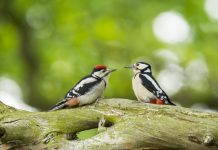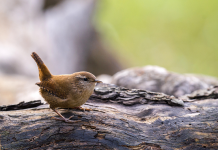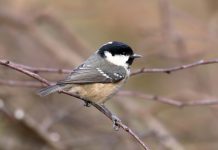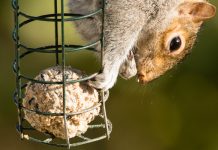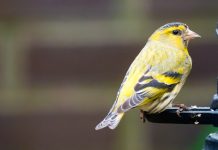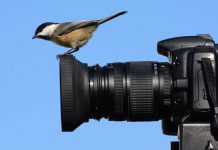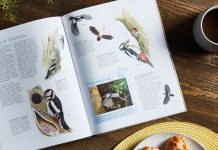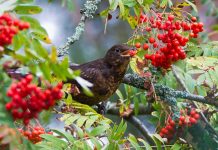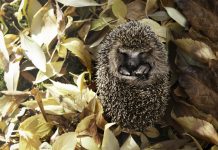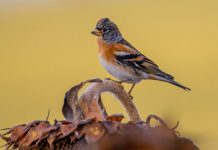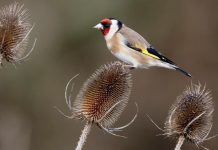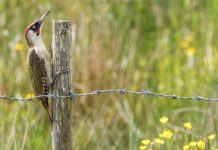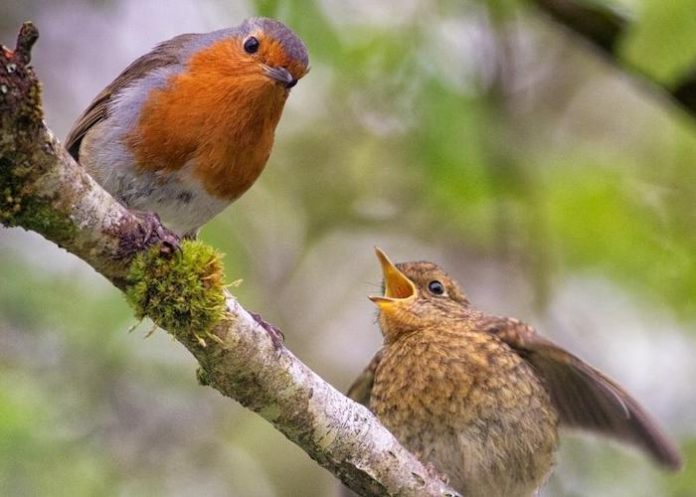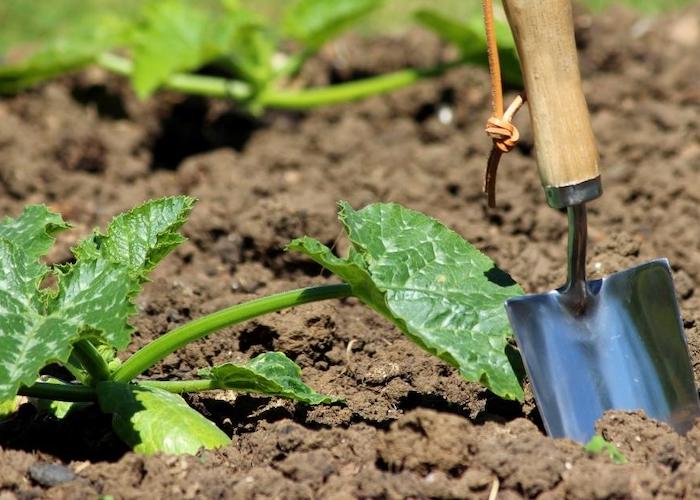A delicate fabric of bird song floats in the air,
The smell of wet wild earth is everywhere
– Sara Teasdale
June marks the beginning of summer and the end of another successful fledgling season. Birds little and large encourage their timid youngsters from the nest as our gardens are filled with a new generation of feathered friends. Sit out on a warm evening and keep a lookout for noisy youngsters and their hardworking parents as they busily forage for insects to feed them.
Long June days mean plenty of time to spend in the garden, and there’s plenty to do! Delve into this month’s Your Happy Beaks Garden to discover birds to spot this month and what you should be doing in your garden in June. There’s also a special feature on how to help wildlife to thrive in your garden, as well as what to do if you find a baby bird!
Garden Birds to Spot in June
Swallow
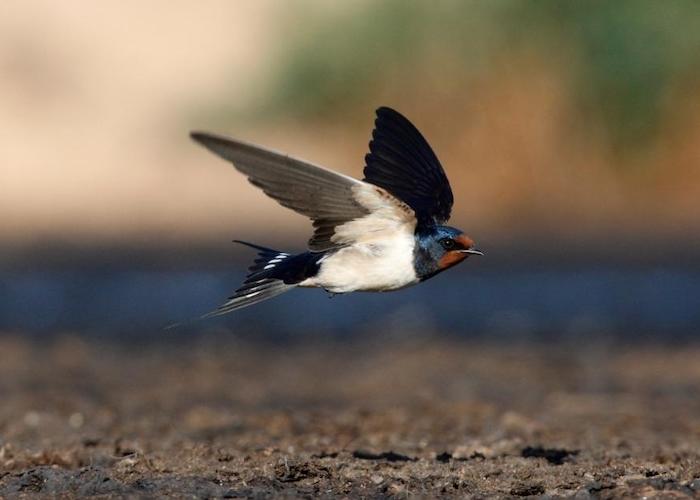
Image: Alamy
Look out for this quintessential summer visitor nesting in eaves or outbuildings, circling above the garden on a summer’s evening, skimming low over fields of crops, or swooping down to your pond to catch insects just above the water’s surface. With a streamlined and elegant silhouette, a swallow in flight can be distinguished from a swift by its markedly forked tail, dividing into two long prongs. If you’re lucky enough to get a closer look, you’ll be able to admire its vivid blue plumage and bright red head.
Did you know?
- Swallows spend most of their time in flight, even catching and eating food on the wing and drinking without landing.
- Fledgling swallows are already able to fly by the time they leave the nest! This means they are one of very few fledglings that should never be found on the ground. Read more about what to do if you find a baby bird.
Cuckoo
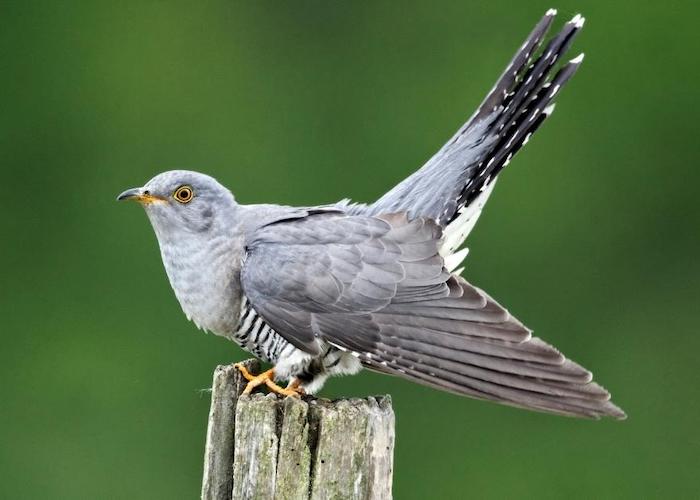
Image: Shutterstock
Traditionally a symbol of late spring and early summer, the cuckoo is a bird you often hear but don’t often see. In fact, the distinctive sound of the cuckoo is much less common around the British countryside than it once was, since this intriguing bird has gone into decline in recent years and is now classed as globally threatened.
The cuckoo has a fascinating lifecycle. It is a summer migrant, overwintering in the forests of the Congo and migrating to the UK to breed, arriving in April and starting to leave again from June. The cuckoo is also famously a brood parasite, with the female seeking out another bird’s nest (often that of a dunnock, pied wagtail, meadow pipit or reed warbler), kicking out one of the host’s eggs, and replacing it with one of her own. The unknowing host bird then raises the cuckoo chick as if it were its own. The young cuckoo will kick out the host bird’s own eggs or young chicks to ensure it receives the maximum amount of food, and makes cries that sound like a full nest of chicks to fool the parent bird into working even harder to feed it.
Did you know?
- The iconic ‘cuck-oo’ call is actually only made by the males.
- Cuckoos can lay anything up to 25 eggs in a single summer, all in different nests, before returning to Africa.
- Because the host bird will reject an egg that looks markedly different from its own, cuckoos have evolved to lay eggs that look similar to those of its host. For this reason, a cuckoo will generally select a nest of the same host species that raised her in which to lay her eggs.
Learn more about the life of the cuckoo in our interesting article.
Goldfinch
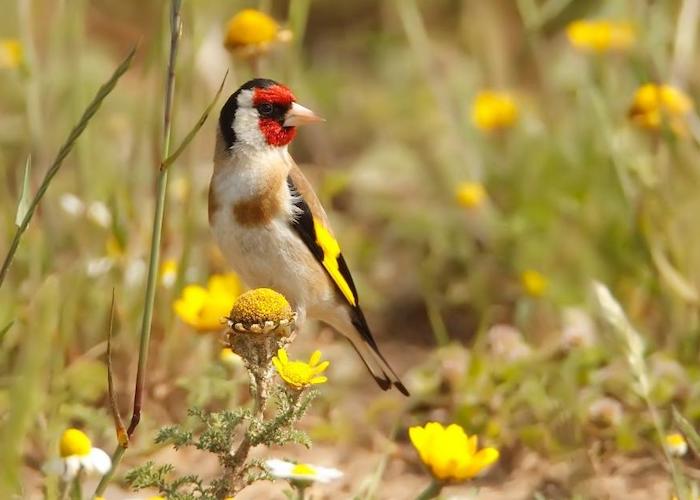
Image: BigStockPhoto
The goldfinch is a beautifully coloured bird, unmistakable with its bright red face and golden yellow wing bar. Though they feed mainly on the seeds of thistles, teasels and sunflowers, at this time of year goldfinches can often be spotted high up in trees foraging for insects; their distinctive twittering ‘tickle-it tickle-it’ call betraying their presence. Goldfinches are also increasingly common visitors to bird feeders, where they are particularly partial to niger seed.
Did you know?
- In the Victorian era goldfinches were commonly kept as caged birds, causing a massive population decline. Turning this decline around was one of the first priorities when the Society for the Protection of Birds was formed (which became the RSPB).
- Goldfinches usually nest on the outermost twigs at the tips of branches, and are especially fond of nesting in fruit trees.
- In the autumn, goldfinches form flocks sometimes numbering a thousand individuals, which often migrate to overwinter in the Mediterranean.
Gardening in June
This year is flying by and summer is now just around the corner. Bringing warmer temperatures and extra sunlight, June is the ideal time for outdoor sowing and planting out of vegetables and bedding plants.
Veg Gardens
- Planting out: Harden off and plant out tender vegetables such as courgettes, tomatoes, beans, squash and sweetcorn. Sprouts, cauliflowers and cabbages can also be planted out.
- Tomato plants: Pinch out any side shoots from your tomato plants. If you like, you can pot these up to create new tomato plants. Start to feed regularly with Tomorite or another high-potassium feed once the first truss has set fruit.
- Pest protection: Protect your crops from carrot root fly using insect-proof mesh. Resisting the temptation to thin out your carrots also helps to protect them, as the smell released when thinning can be detected by carrot root fly from as much as a mile away, bringing them flocking to your patch from far and wide!
Flowers & Bulbs
- Sweet peas: Start picking sweet peas as soon as they flower to encourage more blooms. If seedpods are allowed to form, this will inhibit flowering, so deadhead any you don’t manage to pick.
- Spring bulbs: Remove any dead foliage from spring-flowering bulbs. Tulips can be lifted and stored ready for replanting in the autumn. Also make sure to remove any seedheads from bulbs staying in the ground for a better display next year.
- Staking: Stake the stems of tall perennials such as delphiniums and hollyhocks as they grow, tying them in to a sturdy cane to prevent them from being blown over.
Wildlife Gardening
- Bird baths: A bird bath will be a very welcome addition to your garden, particularly as the weather warms up. Make sure to keep it clean and topped up regularly with clean water for them to safely drink and bathe in. For more information, see our handy guide to bird baths.
- Ponds: This year’s young frogs, toads, newts will be leaving the pond for the first time to seek out damp, shady spots in the garden so make sure there is a little ramp at the edge of your pond to allow them to come and go.
- Feeding garden birds: Things like sunflower hearts and mealworms will be ideal. You could try soaking the mealworms for a tasty treat!
Read our blog for more hints and tips on how to care for garden birds this summer.
Fledgling Season
Throughout summer, it’s not uncommon to find a baby bird sitting on the ground by itself or hopping around without any sign of its parents. A fledgling will look fluffy and have its first coat of feathers, but not its full adult plumage, so the feathers will be loose and soft.
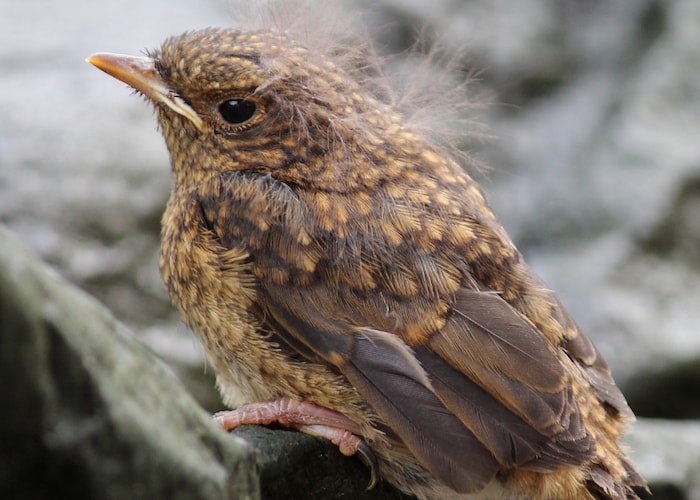
Image: Happy Beaks
What should I do if I find a fledgling?
Nine times out of ten there’s no need to worry about it – they are doing exactly what they should be doing, and have deliberately left the nest a little while before they are able to fly.
It may be tempting to pick the bird up; however, this will do more harm than good, as fledglings are extremely unlikely to be abandoned by their parents. Remember, just because you cannot see the adult birds, that does not mean that they aren’t around. In fact, they are probably out collecting food for their little ones or hidden away up high keeping an eye on how their baby is getting on. So leave them where they are, under the care of their own parents.
Read our blog for more information on what to do if you find a baby bird.
Following this advice will give fledgling birds a greater chance of survival and help ensure they grow to full strength, when hopefully, you can enjoy watching them feeding in your garden!
National Garden Wildlife Week
National Garden Wildlife Week ran from the 27th May – 2nd June 2024. It’s a week created to celebrate wildlife-friendly spaces in your garden and increase awareness of the importance of gardens to wildlife. But just in case you missed it, here’s a summary of things you can do to help out wildlife beyond National Garden Wildlife Week!
A healthy organic garden is a well-balanced ecosystem that can support a myriad of creatures little and large. Urban gardens are particularly important in providing a network of oases of habitat in an otherwise inhospitable landscape. Here are a few ways you can give wildlife a helping hand in your own garden!
Hedgehogs
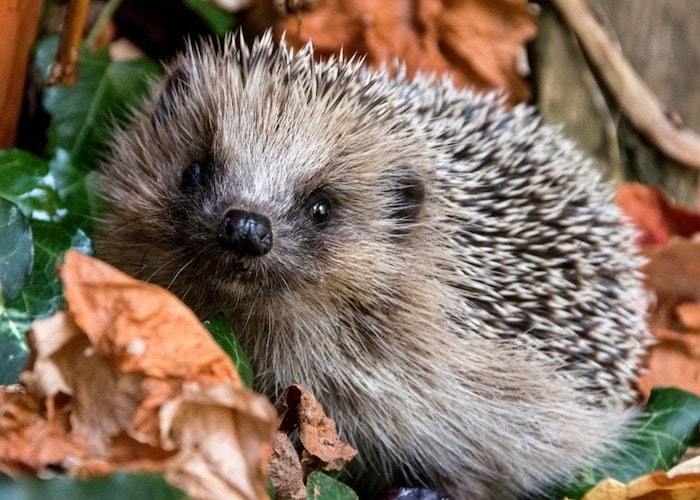
Image: Shutterstock
Connectivity is crucial for an ecosystem to remain resilient and sustainable. This is particularly true of our urban gardens and especially for urban populations of hedgehogs. So if you live in a town or city and have a solid fence around your garden, consider making a small 15x15cm (6x6in) hole at the bottom of the fence on each side to allow these spiny friends to pass through. In return, they will help to rid your garden of slugs and snails! Beetles and a variety of other insects will also be on the menu.
Hedgehogs rely mainly on hearing and smell because they have very bad eyesight. Read more about why hedgehogs are fascinating creatures here.
Pollinators
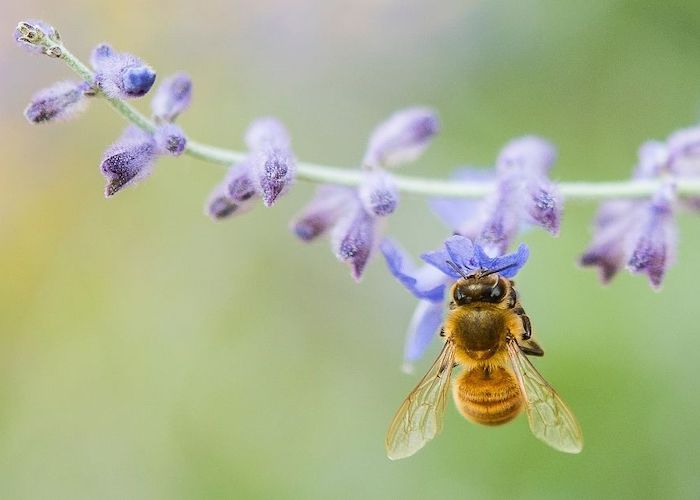
Image: Shutterstock
We depend on pollinators for our food, for a functioning ecosystem and for the landscape as we know it. To attract important pollinators such as bees, butterflies, hoverflies and moths, choose and plant flowers that are rich in pollen and nectar. Some of the best plants for pollinators include Nepeta especially ‘Six Hills Giant’, Knautia, Pulmonaria and Pussy Willow. Try to add a couple of these valuable plants to your garden to give these essential insects a much-needed helping hand.
Earthworms
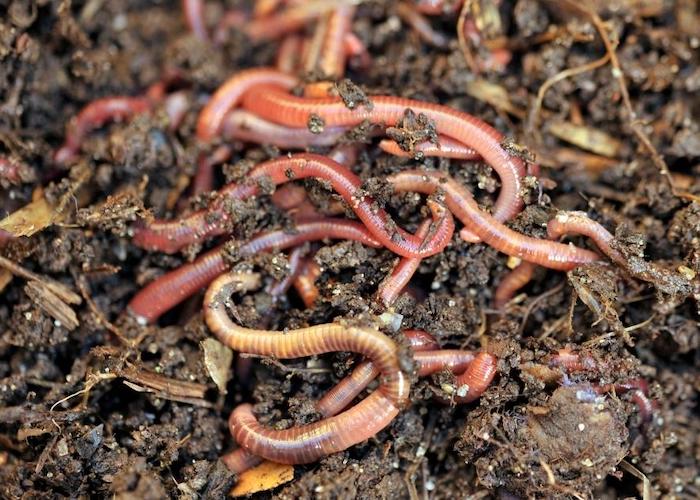
Image: Shutterstock
Earthworms are vital for maintaining the health of your soil. Wriggling around amongst the roots, they munch on decomposing material such as decaying plant matter and dead leaves, which is then deposited in a partially digested form that revitalises the nutrients in the soil. Not only does this mean more key nutrients for your plants, but the worms’ movement also helps to aerate the soil so that plant roots receive the oxygen they need.
To boost your earthworm numbers, keep tilling to a minimum, and keep soil covered as much as possible – try using a green manure instead of leaving soil bare outside the growing season. Adding homemade garden compost or well-rotted manure to soil to boost the organic matter also helps, as well as helping your plants flourish!
Garden birds
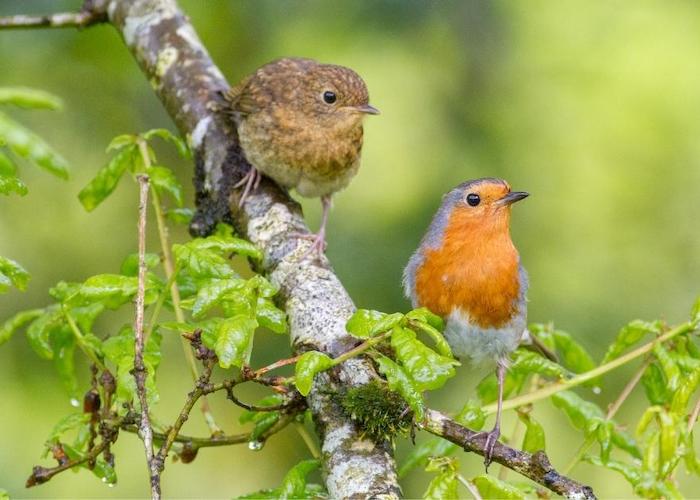
Image: Shutterstock
To encourage birds to your garden, put out a variety of feed from aflatoxin tested peanuts to a seed mix, and watch the birds flock to your garden! Something that is just as important is to offer a source of water for them to drink from too – a bird bath. You can even help them by putting up a nest box. Consider planting a native hedgerow to replace a fence in order to provide birds with valuable extra habitat, nesting sites and food sources.
Remember to hold off on any trimming of hedges or shrubs until August/September, as birds may still be nesting until then – even if you aren’t aware of any nests, as they can be very hard to spot in a dense hedge! August and September are the best time to cut hedges in any case, as they will then hold their shape throughout the autumn, winter and spring, allowing you to only cut them once a year.
Read more about helpful animals to encourage in your garden here.
#SnappyBeaks
Thank you to everyone who has entered our #SnappyBeaks competition this month. We love seeing your entries! Each month we showcase some of your best birdy snaps, in the garden and in the wild, and give you a chance to win a prize in the process.
Get Snappy with Us!
It’s so simple to enter! Just share your photo with us on any of our social media platforms, using the hashtag #SnappyBeaks. You can enter via Instagram, Facebook, Messenger or Twitter. As long as your photo is related to bird feeding or wild birds in some way, we’ll consider it as a valid entry. Click here to find out more.

